Of course the most obvious change is the recently built de Young Museum located at the northern part of the park close to 10th avenue. The previous de Young Museum was completely torn down due to earthquake safety concerns.

The new de Young houses one of the most extensive African and Polynesian arts in the U.S. and has actually given a few acres of public space back to GGP while increasing their own display space. It costs $10.00 per visit and is free on the first Tuesday of every month.

The de Young also has a sculpture garden, with the "Corridor Pin, Blue" as its centerpiece. This pin was made in 1999 by a married couple, Claes Oldenburg (Swedish) and Coosje Van Bruggen (Dutch). They married in 1977 and have been collabortaing on their work since.
Next to the new de Young is the 110 year old Japanese Tea Garden. It is truly a gem and the story behind it is heartbreaking to say the least.
For the 1894 event, California Midwinter Fair, the first acre of the Japanese Garden was created. It was initially called the Japanese Village Exhibit. After the event, Makoto Hagiwara, who designed and built the exhibit, requested to make it a permanent garden and he was able to expand it to five acres from one and the name was changed to the Japanese Tea Garden. Mr. Hagiwara and his family lived on the property in a 17-room house in the sunken garden. Mr. Hagiwara was a landscape designer and made lots of money, but all of it was spent on this garden and he and his family were never reimbursed for their expenses and work.
Makoto Hagiwara died in 1925 and his son died 12 years later. Mrs. Makoto Hagiwara and her children worked hard to keep the garden's plans moving forward, which included planting 1,000 cherry blossom trees (which they accomplished). In 1942, the family was evicted from the garden and placed in internment camps, never to return to the property to live on again. But today the family is still working on the garden and trying to fullfill their great-grandfather's wishes. Admission is $3.50 per person and from 8:30 am to 9:00 am, it is free to enter.
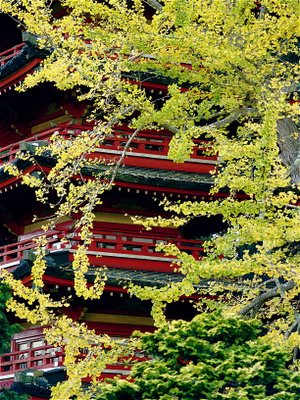
The Buddhist Pagoda or "Treasure Tower" was also built in 1894 and has been moved 60 feet from its original site. The garden is spectacular in March (azaleas are in bloom) and April when the cherry blossoms, well, blossom.

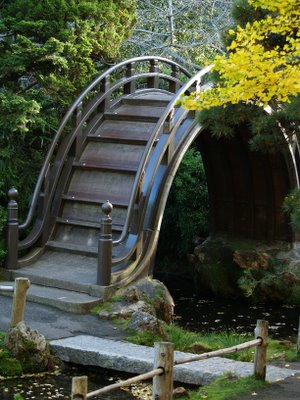
The Moon Bridge looks great in the small river, forming a perfect circle.
Mr. Makoto Hagiwara was the person to bring the fortune cookie to America. He included it as part of the Midwinter Fair but local Chinese restaurants copied the idea and took credit for it. It was only years later that Mr. Hagiwara was credited with starting the foturne cookie... it is a Japanese tradition, not Chinese.
Backtrack past the de Young and you will run into the Conservatory of Flowers building. It was built in 1878 and opened in 1879.

In 1883 the boiler exploded and completely destroyed the dome. In the 1950's the wooden frames were rotted and needed to be replaced and in 1995 a severe storm with hurricane-force winds destroyed the structure which took over $25 million and 8 years to restore. It reopened in 2003. The cost is $5.00 per adult and the first Tuesday of every month is free.

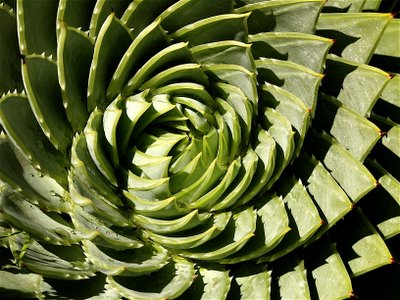
These were just two of the many plants found in Golden Gate Park. Take the time to go off the beaten path, you will be amazed at the sights and sounds and smells. They even have bison in the park, as well as more local flora and fauna.
Go as far west as you can and you will run into Ocean Beach (photo below). To the north is the Cliff House (also in the photo below) and beyond that is the sister home to the de Young, the Legion of Honours, with its European and American art. Beyond that is the Presidio.

The Presidio, which started as a Spanish military outpost in 1776, has become a national park. After the U.S. took over California from Mexico (Mexico declared independence from Spain in 1821), it became an army base, but in 1994 it became a national park with historical buildings and newer barracks (1950's) that are now rented out (at pretty high rent) to help support the park. It is hoped that by 2010 the park will be completely self-sufficient.

The Presidio is an oasis for plants and animals and they tightly control its residents from planting invasive plants that may compete with its unique mix of introduced plants. The woods are covered in pine and eucalyptus, which tower for 100's of feet above you. Above, beyond the woods, is a military cemetery of 15,000 soldiers from many wars.

The views of the city are great from the Presidio, including the northbay. You can see the rotunda of the Palace of Fine Arts (there is no art here by the way), which was built for the 1915 Panama-Pacific Exposition and is the only structure still standing from the exposition. It was originally built as a temporary building and was only saved after public outcry demanded it not be torn down. Beyond this is Alcatraz, the famous prison which started out as a military outpost (in 1859), then in 1907 became a military prison (and the current prison was built by military prisoners from 1909 to 1912) and from 1934 to 1963, it was a maximum security federal penitentiary

One of the most western parts of the Presidio include the Golden Gate Bridge and Baker Beach. Baker Beach has great sand and is very secluded and houses the city's only accepted nude beach, in the most northern sections of the beach.
If you head south from Golden Gate Park and Ocean Beach (you can even walk along the beach to it), you will run into Fort Funston.
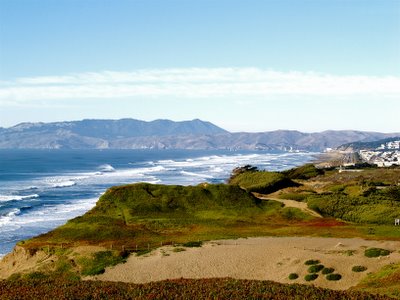
Fort Funston has become a dog owners paradise with well over 100 dogs visiting the park at any one time. The views of the ocean and the Marin Headlands are stunning. Roads that were once used are now allowed to slide down into the beach area and be reclaimed by the ocean.

I call this little beach area the mini Planet of the Apes, with the feeling that civilization has ended and the natural world is once again taking over.
All of these places can easily be visited on bicycle, just take your time and don't worry if you need to walk your bike up some of the steep hills in the Presidio and at Fort Funston.
If you still have the energy or maybe the next day, go to the Ferry building at the opposite end of the city, at its most eastern end.

The ferry building, which was built from 1896 to 1903, is still a vital part of the city. It was saved during the 1906 earthquake and fires from fireboats pumping water from the bay. Today it houses a great multitude of specialty shops that sell gourmet meats, cheeses and olive oils. In its hayday, before the bridges were built (Bay Bridge built in 1936), 100,000 people passed through this building on a daily basis. You can still go through this building to take a ride to Sausalito and other nearby neighbors.
Across the street is the Embarcadero, a huge area of shops and plazas, which include the Vaillancourt Fountain (left on the above photo) which is part of the Justin "Pee Wee" Herman Plaza. The locals call it "Pee Wee", but the two people have no real connection. It was built in 1971 by Canadian artist Armand Vaillancourt. What is interesting about this structure is you are actually allowed to climb on it and through it.

In the nearby Rincon Park (just to the right of the Ferry Building) is a public art structure that people either love or hate. It is called "Cupid's Span" and was designed to resemble the cable and towers of the nearby Bay Bridge as well as a visual reminder of the Spanish fleets' hulls, masts and riggings from centuries past. And the artists? You guessed it, the same two who made the "Corridor Pin, Blue" at the de Young.
And then on a strictly personal note, this is the view I have from my bed, every night and morning. It is St. Ignatius Church, which was completed in 1914. It is part of the University of San Francisco.
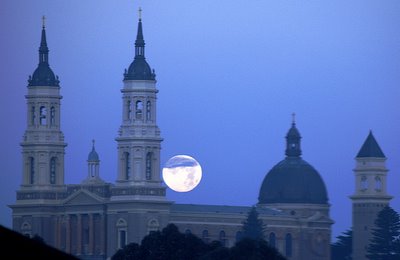

1 comment:
Thanks for the fantastic overview of the public art in SF, it was great.
Onanite
Post a Comment